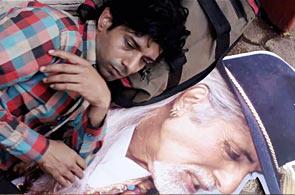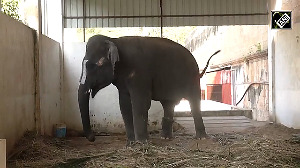 Bombay Talkies is magical in parts, writes Raja Sen.
Bombay Talkies is magical in parts, writes Raja Sen.
Why do we love the movies?
Why do we stiffen with anticipation when that censor certificate flashes on the big screen, its signatures the size of couches, even when I may already be warning us that the film may be interminably long?
Why does popcorn taste better when the lights go down?
Why do we root for some movies and debate passionately against others?
Why do we care about stray opinions expressed by people who don’t matter about our favourite actors who, clearly, do?
Why do we let movies sunnily melt our cynicism or grimly erode our optimism with just a couple of scenes? And why, oh God why, does it feel so damned good when a movie makes us cry?
Bombay Talkies, a four-film collection of movies about Hindi cinema, is a portmanteau project that might not aim to provide a definitive answer to those questions, but is a film that certainly likes to wonder aloud, alongside us.
There are four films, each roughly 25 minutes in length, made by four very different kinds of filmmakers, each a champion in their own right: Karan Johar, Dibakar Banerjee, Zoya Akhtar and Anurag Kashyap have made these films, and each, in a way, has unmistakably left their comfort zone behind in this commendable effort to high-five the movies.
***
Johar’s film, which will invariably be the most talked about of the lot, is more statement than film.
It is a bold, sensitively handled drama about an inert marriage and, perching on its fringes, a young man bursting with pluck and defiance. It is not about a homosexual, but one of the characters happens to be gay.
It is a film about old Hindi film music, with Johar expertly reappropriating classic songs, classic lyrics, and making them heartbreaking in a whole new way. It is about overfamiliarity, friendship and about how a man can drag another to a place of sheer wonderment.
Saqib Saleem, who was last so impressive in Mere Dad Ki Maruti, is excellent here, playing it far too cocky in a bid to overcompensate for his fragility.
It rings true while being anything but cliched. Rani Mukherji plays his increasingly indulgent boss, a woman who wears her blouses slinky and her eyes sad, and the actress is perfect in the part.
Randeep Hooda, as her husband, is problematic: he’s suitably subdued but a bit too awkward throughout the proceedings -- even a character steeped in self-denial should know something about himself.
Johar’s first scene is searingly explosive, a great cinematic jolt, following which it first hiccups with some on-the-nose overfriendly banter, and then steadies and settles into a more predictable narrative.
And it could have been flat if not for the beautifully used music. Johar’s is a film that loves language -- one “Come in?” “Come out?” moment is particularly gorgeous -- and the way he melancholically paints his frames to accompany the words “ki sabse door ho gaye,” is exquisite.
It is also a film made by a maker less sure of the format. The camera is tight and intrusive, as it should be, but perhaps too eagerly, too often. There are a few too many shots of a more ‘cinematic’ composition -- of people looking on in loneliness from sea-facing balconies, for example -- which sometimes jar with a narrative this stark.
Because, stripped of its makeup -- as savagely as its actress peels off her own, in one alarming scene -- this is the most vital film of the lot.
***
A truly great director does not need trained actors, a fact which led the master Satyajit Ray to use lots of non-professionals in his films.
It is a method frequently used by Dibakar Banerjee to terrific effect, populating his films with the unfamiliar and the awesome.
It is this that might have led Ray to write the short story called Patol Babu, Film Star that Banerjee’s film is based on; and it is ultimately deliciously ironic that, with this very short, we discover just how good things can get when a brilliant director does indeed collaborate with a highly accomplished actor.
Nawazuddin Siddiqui, that wondrous chameleon, seems to get better with each cinematic bound, and he’s at his absolute best in this wily adaptation.
Mopping up the floors as he talks to his wife, Siddiqui nimbly takes the mop and cleans under his own feet before he steps onto the freshly wiped floor. This is a film that revels in the most acute, the most magnificent detailing.
Even in the chawl they live in, Siddiqui’s daughter sleeps beside a Hannah Montana pencilbox. It is a film of many and varied joys, one of the finest and quirkiest going by the name Anjali.
Siddiqui plays a failed entrepreneur who strays onto a film-set and is snapped up as an extra, and much magic follows, most of which I should allow you to experience first hand, without knowing what you’re in for.
Siddiqui is spectacular, Sadashiv Amrapurkar (as his overbearing, omniscient father) is perfectly cast and quite special, and Shubhangi Bhujbal is spot-on as Siddiqui’s wife; a particular moment -- when she assures him that nobody can turn him down by asking if she herself could say no to him -- is one to cherish.
It’s a remarkable film, unmistakably carrying the auteur’s stamp in every frame. (No mean feat considering just how much it borrows from Ray; from his films and his fiction: Anjali constantly made me think of Big Bill, for example.)
The shots are desolate, beautiful, gorgeous and the writing is crafted excellently. It is about the magic-dust the movies sprinkle on everyone within range, but more than that it is about a director himself overreaching: taking a story from the master and cleverly doodling enough around the margins to make it his own, and also taking a song from Rabindranath Tagore and himself composing music to compliment a devastatingly good final shot.
These are salutes that must in turn be saluted.
***
I want to be a football, says a kid wearing a Lionel Messi jersey in the adorable opening montage of Zoya Akhtar’s film where children of various ages, shapes and heights tell the camera their dreams. (A boy, wearing a fullblown superhero costume, is one I identified with the strongest.)
This film isn’t about us, though, it’s about a kid who looks at the girls in tights longingly (not like that, no) while being forced into football practice; about a kid who wants to be Katrina Kaif.
It’s a simplistic fairytale of a film with clear-etched character archetypes -- Strict Dad, Submissive Mom, Sweet Sister -- and that suits both narrative and format.
The youngster who dreams of glitzy outfits and high-heels is played by Naman Jain and he is simply fantastic, carrying the whole film off remarkably well.
Kaif has a cameo, wings and all, but her being chosen for this film is itself interesting, considering that till before Sheila Ki Jawaani -- the song that makes this boy lean forward, agog -- she wasn’t even considered a dancer.
Dare to dream, but dream covertly, she tells the boy who drinks it in. It’s a sweet film, with some great touches of dialogue, that climaxes with simplicity and sunniness.
***
Anurag Kashyap’s film does what most of us have done, at least at some point: it mythologises Bachchan to the hilt.
The narrative is weak (the plot is very reminiscent of Steven Spielberg’s The Terminal) but the masala spirit more than willing, and Kashyap churns out something both nuanced and nutty. In that sense, there may be no better conceivable tribute to Hindi cinema.
An Allahabadi youngster bolts from the Kumbh Mela to see his bedridden father who (after some top-notch Dilip Kumar mimicry) sends him off to see Amitabh Bachchan carrying a gooseberry, a solitary murabba in a jar.
His mission: to get Bachchan to take a bite and bring back the half-eaten, megastar-indentured murabba so that the father can get better, bite by Big-B-endorsed bite.
The dutiful son (appropriately named Vijay, naturally) wears a scarlet, Coolie-coloured shirt and makes his way to Bachchan’s, thinking that the most famed of Juhu dwellers would take in all who hail from his hometown.
The film is propelled by Vineet Kumar Singh’s stellar performance in the role, and while Kashyap crafts a nice-looking film with some delicious dialogue, this is a film that emerges half-baked.
The struggle works but the end is a sham, and the cameo in the middle almost ruins everything. Or maybe the director was aiming for half-eaten?
***
Right after Kashyap’s film ends bolt towards the door.
Because after all this, after four directors doing their best to celebrate Hindi cinema, the film’s producers massacre things by throwing in a horribly tacky song that starts with ghastly YouTube-style lipsyncing and ends with Bollywood at its most disposably shiny.
Even if Anil Kapoor’s having fun dancing his Lakhan steps, nothing justifies this atrocity. Run, I tell you, hold on to your murabba jar of movie memories and flee.
***
So then four films. Four statements. Four attempts.
In the final reckoning, Bombay Talkies is mostly good, with one spectacular film and three that are, at worst, earnest -- a collection that deserves to be watched for what it tries to celebrate more than what it ends up being.
But like we say about so much of Bollywood, go for the magical bits.
Rediff Rating: 
Also Read
Review: Bombay Talkies, an engaging ode to cinema











 © 2025
© 2025